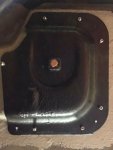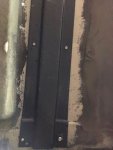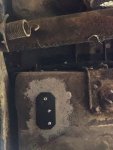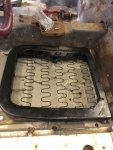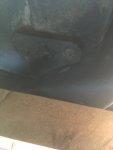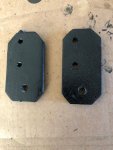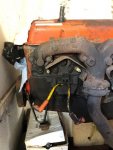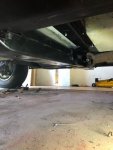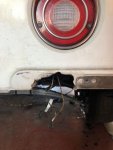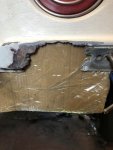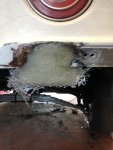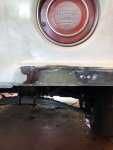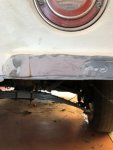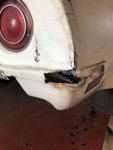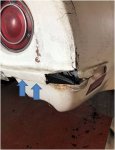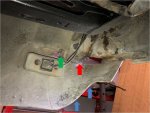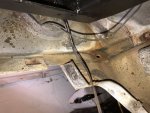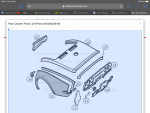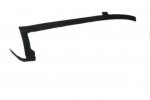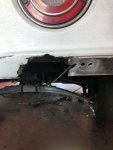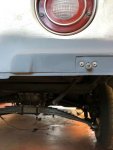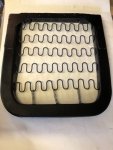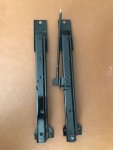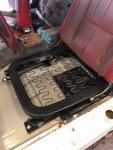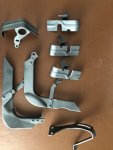With the temperature approaching a heady 3 degrees I have ventured to the workshop once more to finish the driver's seat......
As predicted the seat back support bolt that had sheared in the seat base was a nightmare to remove and despite my best efforts I had to resort to a drip and tap to resolve the problem.
A steel reinforcing plate was made up with holes drilled out in the appropriate places and riveted in place to check for alignment. You can also see one of the two small reinforcing plates for the seat back pivots.
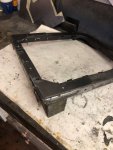
Then the base was rejoined with the back to make sure that the strengthening pieces fitted were still allowing everything to work properly. I've used (mainly) new hardware as the old ones were in pretty poor shape.
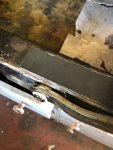
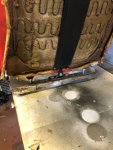
All seemed to work ok and so the plate was welded on and the entire base painted
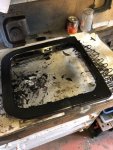
I had purchased an excellent set of tracks from a fellow club member but I had not realised that the '72 and later tracks are about 30mm longer than the 69-71 equivalents. One of my old non-serviceable tracks was cut and a section added to the 'new' ones. It's surprising how many quite significant design changes there are between model years. I wonder what prompted GM to g to the trouble of redesigning the floor pan and seat mount arrangements.
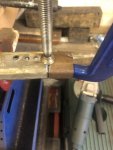
This now gives a set of tracks with the correct lengths for my car.
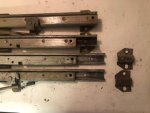
The 'arrow' mounts were then switched around - they face the other way around on later tracks - and fixed back on. I have left the original rivet hole on both tracks (only one had the 2 spot welds filled when the photo was taken) so that the process could be reversed easily if required.
So that just leaves.... a little bit more painting to be done, the reinforcement plates to be rivetted back in to the car and then everything reassembled and tested. With some warmer weather on the way I can probably get that done next week. A lot of work for a driver's seat but hopefully it should be good for another 49 years and I've learned a few things along the way.
As predicted the seat back support bolt that had sheared in the seat base was a nightmare to remove and despite my best efforts I had to resort to a drip and tap to resolve the problem.
A steel reinforcing plate was made up with holes drilled out in the appropriate places and riveted in place to check for alignment. You can also see one of the two small reinforcing plates for the seat back pivots.

Then the base was rejoined with the back to make sure that the strengthening pieces fitted were still allowing everything to work properly. I've used (mainly) new hardware as the old ones were in pretty poor shape.


All seemed to work ok and so the plate was welded on and the entire base painted

I had purchased an excellent set of tracks from a fellow club member but I had not realised that the '72 and later tracks are about 30mm longer than the 69-71 equivalents. One of my old non-serviceable tracks was cut and a section added to the 'new' ones. It's surprising how many quite significant design changes there are between model years. I wonder what prompted GM to g to the trouble of redesigning the floor pan and seat mount arrangements.

This now gives a set of tracks with the correct lengths for my car.

The 'arrow' mounts were then switched around - they face the other way around on later tracks - and fixed back on. I have left the original rivet hole on both tracks (only one had the 2 spot welds filled when the photo was taken) so that the process could be reversed easily if required.
So that just leaves.... a little bit more painting to be done, the reinforcement plates to be rivetted back in to the car and then everything reassembled and tested. With some warmer weather on the way I can probably get that done next week. A lot of work for a driver's seat but hopefully it should be good for another 49 years and I've learned a few things along the way.


